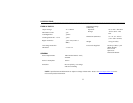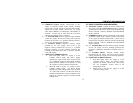
13
___________________________________________________________________________OPERATING INSTRUCTIONS
Hook-up
3. Set the INDEPENDENT/TRACKING mode switch to
the right position so that the power supply is in the
INDEPendent operating mode.
4. Set the A/B Metering selection switch to the A (up)
position to monitor the “A” supply.
5. Turn off the power supply and the equipment to be
powered during hook-up.
6. Connect the positive polarity of the device being
powered to the red (+) terminal of the power supply.
7. Connect the negative polarity of the device being
powered to the black (-) terminal of the power supply.
8. Fig. 3 illustrates the grounding possibilities when used
in the INDEPendent mode.
a. If the negative polarity of the equipment or circuit
being powered is also the chassis or common, it may
be grounded to earth by strapping the black (-)
terminal to the green (GND) terminal as shown in Fig.
3A.
b. Similarly, the positive polarity can be grounded by
strapping the red (+) terminal to the green (GND)
terminal as shown in Fig. 3B.
c. If an earth ground reference is not required, the
configuration of Fig. 3C may be used. The scheme in
Fig. 3C should also be used where it is not known
whether the chassis is common with either the
positive or negative polarity.
d. If the chassis or common of the equipment being
powered is separate from both the positive and
negative polarity power inputs, use the connection
shown in Fig. 3D.
1. Observe proper polarity. If the circuit being powered
is not equipped with reverse polarity protection,
damage to the circuit can result from reverse polarity.
Use color coded hook-up leads, for convenience in
identifying polarity, red for (+) and black for (-).
2. Make sure that the hook-up leads offer sufficient
current capability and low resistance between the
power supply and the circuits being powered. The
hook-up leads supplied with the power supply are
rated for 4 amp.
Typical Constant Voltage Operation
1. Before connecting the device to be powered to the
power supply, determine the maximum safe load
current for the device to be powered and set the
current limit value (see “Setting Current Limit”
procedure in this section).
2. Set the A/B Meter selection switch to the A (up)
position to monitor the “A” supply.
3. Set VOLTAGE control to minimum (fully
counterclockwise).
4. Turn off power supply and connect it to the device
to be powered (see “Hook-Up” procedure in this
section).
5. Turn on POWER switch. The CONSTANT
CURRENT indicator should not light.
6. Increase the VOLTAGE setting until the Volt meter
reads the desired value.
7. The load current is read directly on the mA meter.


















